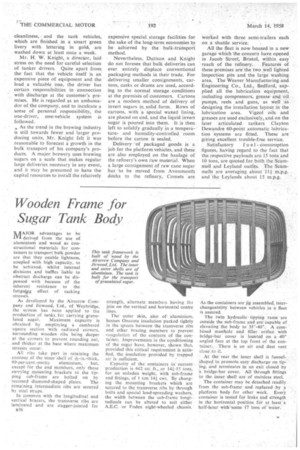Wooden Frame for Sugar Tank Body
Page 110

If you've noticed an error in this article please click here to report it so we can fix it.
MAJOR advantages to be nri derived from the use of aluminium and wood as constructional materials for containers to transport bulk powder are that they enable lightness, coupled with high capacity, to be -achieved, whilst internal divisions and baffles liable to obstruct discharge can be dispensed with because of the inherent resistance to the fatiguipg effect of racking stresses.
As developed by the Airscrew Company and Jicwood, Ltd., of Weybridge, the system has been applied to the production of tanks, for carrying granu lated sugar. Maximum capacity is obtained by employing a cambered square section with radiused corners, surrounding woodenribs being deeper at the corners to prevent rounding out, and thicker at the base where maximum stresses occur.
All ribs take part in retaining the contour of the inner 'shell of -6;-in.-thick, 99-per-cent.-purity aluminium, but, except for the end members, only those carrying mounting brackets to the tipping sub-frame are bolted on by
recessed diamond-shaped plates. The remaining intermediate ribs are secured by steel straps.
In common with the longitudinal and vertical bracers, the transverse ribs are laminated and are stagger-jointed for
$36 strength, alternate members having the join on the vertical and horizontal centre lines.
The outer skin, also of aluminium. houses Onazote insulation packed tightly in the spaces between the transverse ribs and other bracing members to prevent coaEulation of the contents of the container. Improvements in the conditioning of the sugar have, however, shown that, provided this critical requirement is satisfied, the insulation provided by trapped air is sufficient.
Capacity of the containers in current production is 642 cu. ft., or 14-,3,-I5 tons, for an unladen weight, with sub-frame and fittings, of 1 ton 141 cwt. By changing the mounting brackets which are secured to the transverse ribs by through bolts and special load-spreading washers, the width between the sub-frame longi-tudinals can be altered to suit either A.E.C. or Foden eight-wheeled chassis.
As the containers are jig assembled, interchangeability between vehicles in a fleet is assured.
The twin hydraulic tipping rams are outside the sub-frame and are capable of elevating the body to 35°-40°. A combined manhole and filler °rifled with bridge-bar cover is lotrated On a 40° angled face at the top front of the container.There is an air and dust vent close to it.
At the rear the inner shell is funnelshaped to promote easy discharge on tipbig, and terminates in an exit closed by a bridge-bar cover. All "through fittings to the inner shell are of stainless steel.
The container may be detached readily from the sub-frame and replaced by a platform body for other work. Every container is tested for leaks and strength in the horizontal position for at least a half-hour witlf-some 17 tons of water.












































































































































































